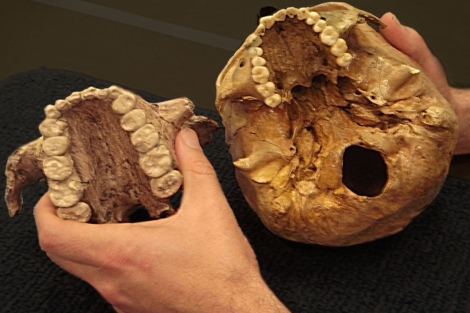En un trabajo que acaba de publicar la revista norteamericana Proceedings of National Academy of Science (PNAS) se plantea otro escenario. Thure E Cerling del Department of Geology and Geophysics de la University of Utah (EE.UU.) y colegas indican que las marcas de desgaste de los dientes indican una dieta más suave como son frutas blandas y hierva. Además han realizado un estudio de los isótopos de carbono que permite inferir de manera directa la dieta. Con estos datos afirman que Paranthropus boisei se alimentaba de grandes cantidades de hierba, la idea es que se parecería más a una vaca en cuanto a su alimentación, que a la idea que tenemos de un primate.
El estudio del isótopos se basa en la diferencia que existe en el tipo de Carbono en las plantas. Así los árboles, arbustos utilizan el denominado C3, mientras que las herbáceas de la sabana usan el C4. Al analizar los isótopos de los dientes de Paranthropus boisei se observo que contenían una mayor cantidad de C4 que de C3. Los investigadores calculan que el 77% de su dieta sería herbáceas. Los resultados para este primate es muy similar a los obtenidos para otros mamíferos de sábana de la misma edad.
La referencia completa en:
Cerling, T.E., Mbua, E., Kirera, F. et al 2011. Diet of Paranthropus in the early Pleistocene of East Africa. Proceedings of National Academy of Science.
Os adjuntamos el resumen de la publicación:
The East African hominin Paranthropus boisei was characterized by a suite of craniodental features that have been widely interpreted as adaptations to a diet that consisted of hard objects that required powerful peak masticatory loads. These morphological adaptations represent the culmination of an evolutionary trend that began in earlier taxa such as Australopithecus afarensis, and presumably facilitated utilization of open habitats in the Plio-Pleistocene. Here, we use stable isotopes to show that P. boisei had a diet that was dominated by C4 biomass such as grasses or sedges. Its diet included more C4 biomass than any other hominin studied to date, including its congener Paranthropus robustus from South Africa. These results, coupled with recent evidence from dental microwear, may indicate that the remarkable craniodental morphology of this taxon represents an adaptation for processing large quantities of low-quality vegetation rather than hard objects.
El estudio del isótopos se basa en la diferencia que existe en el tipo de Carbono en las plantas. Así los árboles, arbustos utilizan el denominado C3, mientras que las herbáceas de la sabana usan el C4. Al analizar los isótopos de los dientes de Paranthropus boisei se observo que contenían una mayor cantidad de C4 que de C3. Los investigadores calculan que el 77% de su dieta sería herbáceas. Los resultados para este primate es muy similar a los obtenidos para otros mamíferos de sábana de la misma edad.
La referencia completa en:
Cerling, T.E., Mbua, E., Kirera, F. et al 2011. Diet of Paranthropus in the early Pleistocene of East Africa. Proceedings of National Academy of Science.
Os adjuntamos el resumen de la publicación:
The East African hominin Paranthropus boisei was characterized by a suite of craniodental features that have been widely interpreted as adaptations to a diet that consisted of hard objects that required powerful peak masticatory loads. These morphological adaptations represent the culmination of an evolutionary trend that began in earlier taxa such as Australopithecus afarensis, and presumably facilitated utilization of open habitats in the Plio-Pleistocene. Here, we use stable isotopes to show that P. boisei had a diet that was dominated by C4 biomass such as grasses or sedges. Its diet included more C4 biomass than any other hominin studied to date, including its congener Paranthropus robustus from South Africa. These results, coupled with recent evidence from dental microwear, may indicate that the remarkable craniodental morphology of this taxon represents an adaptation for processing large quantities of low-quality vegetation rather than hard objects.
LUGAR Tanzania



















